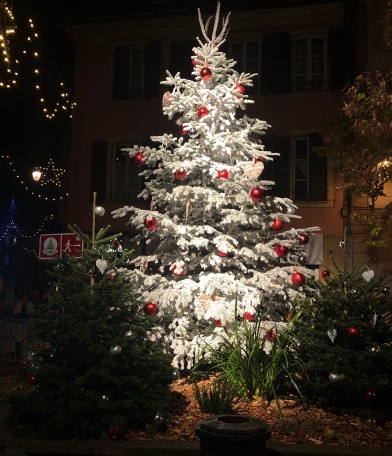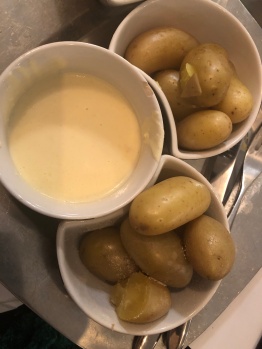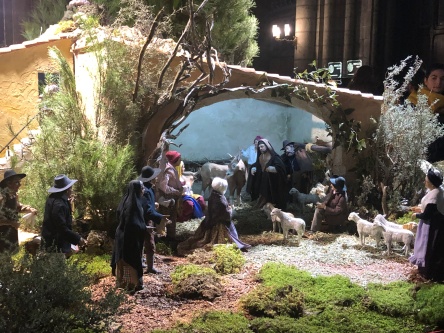Christmas is my season. In September, I become as antsy as a child, wondering if the holiday season will ever arrive. I greet Halloween with disdain and grow impatient with Thanksgiving preparations. As December nears, I head out in search out the most Christmasy spots on the map. The last week of November 2019 found me in the Alsace region of France, which shares a border with Germany.
In my years of research, the Alsace consistently tops the lists of best holiday travel experiences. Before we arrived, I received an e-mail warning that the entire center of Colmar, our base for the week, would be closed to traffic during the Christmas season due to multiple holiday displays and Christmas markets. I read this apologetically worded e-mail aloud to my husband, who responded sarcastically with, “Well, they’ve sent that e-mail to the right person.” I ignored him and danced around the room joyfully singing “It’s Beginning to Look a Lot Like Christmas.”
Day 1: Colmar
We stepped off the train in Colmar to find a Christmas tree display, and I immediately headed into the historic, half-timbered center of town. My husband, bewildered, wanted to know how I found my bearings so quickly. I pointed to the signs saying, “Marché de Noel.” From there, it was a Christmas wonderland. Every building, every square, and even the foliage was decorated. The effect was mesmerizing. I was in heaven.

Colmar Christmas Tree
We arrived early in the evening. We only had enough time to gape in awe at the storybook nature of the town before it was time for the five Colmar Christmas markets to close. The town was busy, but I had secured reservations at Wistub Brenner, a traditional Alsatian restaurant located in the heart of the historic center.
If you are on a diet, you do not want to visit the Alsace. This food is heavy, indulgent, and so, so good. The region has changed hands several times between France and Germany, and the cuisine is an interesting mash-up of German and French. Think cheese plates, fondue, foie gras, sauerkraut, sausage, potato salad, and delicate pastries all found in one place, and sometimes all on the same table!

Traditional Alsatian Meal
Day 2: Mulhouse, France & Basel, Switzerland
The first full day of our vacation landed on a Sunday, which can be tricky in this part of the world, as many shops and restaurants close. We headed 45 minutes south by train to the nearby cities of Mulhouse, France, and Basel, Switzerland, where I knew we’d find plenty to do.
Mulhouse is not particularly charming, but it had a small and enjoyable Christmas market that was open for business. This may sound odd, but you do not need to be a shopper to enjoy Christmas markets. I focus on them as places of traditions, decorations, food, drink, and social gatherings.

Mulhouse Christmas Market
After having a lunch of crepes and hot wine at the market, we made our way to the Cité de l’Automobile, a car museum. This stop was meant as a treat for my husband, but I think I enjoyed it more than he did. I learned quite a bit about the history of cars starting in 1878 to the present day, which I found fascinating.
In the late afternoon, we arrived in Basel. This was a city we visited because it was “in the neighborhood,” and not because it was a must-see destination. I had been influenced by reviews that stated that Basel was “nothing special.” By the end of the evening, I was a huge fan, and I wished we had budgeted more time there. We barely scratched the surface of this city, which is the third largest in Switzerland.
Stepping off the train in Basel, one immediately recognizes that you have entered into Swiss territory, as all the signs switch from French to German, the most common language spoken in Basel. Before we left home, we downloaded an excellent series of walking tours on the itour Basel app. We had an entertaining afternoon and evening using the app to gain a broad historic overview of Basel.

Basel Christmas Lights
People have lived in the area for approximately 2,000 years, and the architecture combines a mix of important and beautiful buildings going back to the Middle Ages through modern times. The entire Old Town of Basel has been designated by the Swiss as a heritage site of national significance. Of course, we also visited several Basel Christmas markets, which were lively, crowded and fun.
Day 3: Strasbourg
My husband and I caught the 30-minute train to Strasbourg to arrive in time for lunch. Like Colmar, Strasbourg was a blissful, holiday wonderland with many Christmas markets and displays. Strasbourg is a bigger, more elegant city than Colmar, with so much to see that we were once again disappointed in the limited time we had available.

Christmas in Strasbourg
We started our Strasbourg adventure ordering a flammekuechle, which is one of the specialities of the region. It looks like a pizza, but is really pastry dough covered in crème fraîche, onions, and, sometimes, toppings such as mushrooms. Do not leave the area without trying this dish—it is famous for a reason.

Flammenkuechle
After lunch, we visited the Strasbourg Cathedral, which was constructed starting in the 1100s. The city center of Strasbourg is so dense, that we were somehow surprised as we turned a corner and came face-to-face with the massive, Gothic building. We toured the gorgeous church and spent time at the cathedral’s famous astronomical clock and nativity scene. The most important Christmas market in Strasbourg takes place in the immense square in front of the Cathedral.

Strasbourg Christmas Decor
A river cuts through the middle of Strasbourg, and boat rides regularly leave from the back of the Palais Rohan, a palace and museum in the historic center of Strasbourg. The 70-minute Batorama boat tour provides an informative overview of the Petite France (old tanner’s) section of Strasbourg, which originated in the Middle Ages; the Neustadt (new city) imperial quarter dating from the 1800s; and, further along the river, the modern building that houses the European Union Parliament. I highly recommend taking the boat tour, as it provided much needed history and context to our time in Strasbourg. As a bonus, a small Christmas market with multiple stalls for wine tasting takes place in front of the boat departure point!

Palais Rohan Christmas Market
We concluded our visit to Strasbourg with an outstanding dinner at a restaurant called Le Muns’, which is devoted to a local cheese called munster. The French munster is entirely different than the American cheese. According to cheese.com, the munster in France, also known as Munster Géromé, is a “soft washed rind cheese made from milk produced by cows living in the regions between Alsace, Lorraine and Franche-Comté.” We ordered a munster fondue, and it was so delicious that my husband insisted we purchase a fondue set when we arrived home.

Munster Fondue
A Regretful Word About Security
Security is extremely tight at the Christmas markets. We saw a strong show of police in Colmar and Strasbourg carrying automatic weapons. The historic center of Strasbourg is an island, and all pedestrians were searched entering that island. Yet, a gunman managed to open fire at one of the Strasbourg Christmas markets one week after we visited, killing five.
Terrorists continue to hit Christmas markets because they are places of joy and community. The rest of us must decide whether to live life loudly or cower in fear. I have made my choice, and I wrote about it in Scared to Travel? Go Anyway. The people of Strasbourg also made a choice. They reopened their Christmas markets less than a week after the attack. Instead of a minute of silence, they held a minute of applause in memory of the victims and as a symbol of their resilience.
Day 4: Colmar
By day four, we felt the need to spend some quality time in our temporary home of Colmar. The town dates back to the 9th century, and its half-timbered architecture is typical of the region. Colmar’s city center is rich in historic buildings, with the oldest dating back to the 13th century.

Half-Timbered Cuteness
We meandered slowly around Colmar’s cobbled streets, canals, and markets soaking in the Christmas cheer and ambiance. At the permanent food market, we stopped to buy food for dinner at our apartment. We purchased wine, bread, cheeses, foie gras, charcuterie, jams, fruit, and bredele, a collection of Alsatian cookies

Christmas Market in Colmar
Colmar Restaurant Recommendation – Wistub de la Petite Venise
My husband and I had a delicious, slow-paced, and unforgettable meal at Wistub de la Petite Venise, which serves traditional regional food with an Alsatian ambiance. Colmar is busy this time of year, and reservations are a must.
Day 5: Eguisheim/Kaysersberg
Colmar and the towns and villages near it are part of the Alsace Wine Route. The wines here are different than those produced in my home state of California. I was curious to try dry rieslings (yes, dry); gewürztraminers; and crémants. Until our trip to the Alsace, I had no idea that a crémant was a sparkling wine of France, much like prosecco is a sparkling wine of Italy.
Based on my research, we planned a day of sightseeing and wine-tasting in the nearby medieval villages of Eguisheim and Kaysersberg. We arrived in Eguisheim via a 20-minute taxi ride in time for a late breakfast and then walked a well-worn path around the village oohing and ahhing over the Christmas decorations that appeared over every doorway and window. At the conclusion of our extended walk, we had planned on wine tasting. Here is where we ran into bit of a problem.

Eguisheim at Christmas
In the Alsace Region, there are strict practices about hours that shops and restaurants are open. The shops will welcome customers for a few hours in the morning, and then everything shuts down for lunch from between 12-2 or longer. The restaurants will open from 12:00-2:00 pm, but then close until dinner time at approximately 7:00 or 8:00 pm. Sometimes, they don’t open at all during the day. As a result, planning your meals requires the precision of a military operation.
When we finished our walk in Eguisheim a little after noon, we noticed everything was shut down. Everything. No wineries. No shops. It was cold, there wasn’t a person on the street, and then it started raining. Luckily, the tourist information office was open, and they called us a taxi to take us onwards to Kaysersberg. The taxi did not show up for approximately 45 minutes while we waited in the December cold and rain, because the tourist information office also closed. Lesson learned—plan your time VERY carefully in Eguisheim and in all of the Alsace.

Eguisheim at Christmas
By the time the taxi finally deposited us in Kaysersberg, the rain had stopped, the sun emerged, and our mood improved. We took a small hike from the center of town through picturesque vineyards to the top of castle ruins. When we were finished, the shops had opened, and we meandered through the bedecked historic streets. We attempted wine tasting once again, but we were aggressively rebuffed by the woman at the establishment we picked. To this day, I am not sure what we did wrong.

Christmas in Kaysersberg
Yet, I loved Kaysersberg. Many people were friendly to us, the streets and decorations were gorgeous, and it was surrounded by hilly vineyards. I would visit Kaysersberg again in a heartbeat, and perhaps hire a local to take us wine tasting so that we don’t mess it up again.
Day 6: Riquewihr/Ribeauville
My husband and I hiked between the villages of Riquewihr and Ribeauville. The day was glorious, and you can read about it at: A Christmas Hike in the Alsace: Riquewihr to Ribeauville

Hiking in the Alsace
Day 7: Paris
When planning a trip to the Alsace, one usually arranges to fly into nearby Basel, Switzerland. Before I learned this fact, I had already booked a round-trip flight to Paris, which added an extra two hours to our journey each way. This particular mistake meant that we had to spend a night in Paris before catching our flight home. It would turn out to be one of the better mistakes of my life.
Our train pulled into Paris in the early afternoon. Due to the short winter days, we had time for only one daytime Paris activity. Montmartre or the Musée d’Orsay almost won the vote, but, in the end, we went to Notre Dame. Although my husband and I had both been to the cathedral on prior visits, we had never visited the bell tower.

Notre Dame Rooftop
In a state of ignorant bliss, we spent a fabulous, sunny afternoon overlooking Paris and the historic Notre Dame rooftop. After we climbed down from the tower, we lingered in the cathedral marveling at the Christmas decorations and the most intricate and beautiful nativity set that I have ever seen. We did not know then that a terrible fire would devastate the church in April 2019, only four months later. As I watched the horrifying news coverage of the flames engulfing the cathedral, my accidental trip to Paris turned into a priceless gift.

Notre Dame Nativity Set
Practical Tips
Where to Stay—Colmar or Strasbourg?
A debate rages on the internet about whether it is better to base yourself out of Colmar or Strasbourg when touring the Alsace. Colmar was reported to be more charming, Strasbourg larger and more elegant. I agonized over this choice, and ended up booking an apartment in Colmar for a week. Don’t torture yourself—either location will be fantastic and filled with the Christmas spirit. The best of all worlds would be to split your time, and spend half a week in Colmar and half a week in Strasbourg. (Please note, if you truly enjoy extra-small village living, there are even more options nearby.)
To Rent a Car or Not Rent a Car?
I live in the perfect weather world of Southern California. On the off-chance of icy conditions, I did not want to commit us to driving. Colmar is located on the train lines, which was convenient to visiting towns to the north (Strasbourg), and to the south (Basel, Mulhouse). For towns not located on the train, we took buses and taxis, both of which were accessible in front of the Colmar train station. Despite our wait for a taxi in Eguisheim, I was pleased that we did not rent a car.
When to Go?
My husband and I visited the area from November 23-December 1, 2018. This was a bit early in the season, and there were pros and cons to this approach. Christmas was in full swing in both Colmar and Strasbourg when we arrived. However, the Christmas markets were not up and running in Kaysersberg, Riquewihr, and Ribeauville. Seeing these villages in the quiet before the tourist storm was wonderful, but I also would have enjoyed experiencing them in all their holiday finery. The locals in Colmar told us we were the smart ones to arrive on the first full weekend of the Christmas season. Truly, this is a win-win situation. Go early and get a little more elbow room, or go later and see even more decor!
Christmas Markets
The internet provides a plethora of practical information on the Christmas markets. I found the most useful sites to be:
